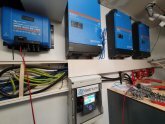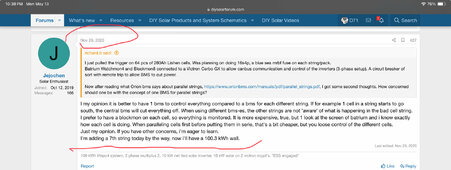You are using an out of date browser. It may not display this or other websites correctly.
You should upgrade or use an alternative browser.
You should upgrade or use an alternative browser.
House burned down
- Thread starter Jejochen
- Start date
Brucey
Solar Wizard
What is going on with that DC disconnect wiring? Three positives going in and three positives out?Be really careful testing those fuses.
Stored energy is dangerous.
After OP showed those pictures am sure fuse and breaker sales skyrocketed. Hopefully this will somehow help other ppl from having a problem.
View attachment 214995
View attachment 214996
View attachment 214998
PotusGobbleBottom
Corn Pop was a bad dude.
Perhaps this would be an excellent avenue to discuss further in this thread?would love to hear from someone who actually know how the insurance process works.
I would love to hear everything I can on this.
Not sure what was changed but think op changed batteries….after these were put up. Link at bottom.What is going on with that DC disconnect wiring? Three positives going in and three positives out?
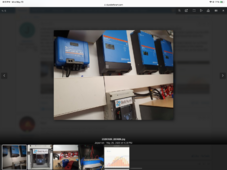
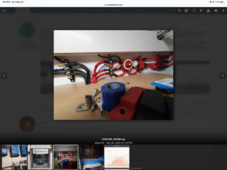
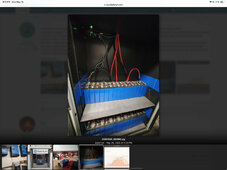

LFP Powerwall
a few pictures of my own built 'home energy system'. I run my house, workshop and if needed charge my tesla model S with it. currently 3 multiplus 2 5 kVa units for 3-phase system, 48 V battery: 3 banks of 16 200 Ah cells, monitored by batrium. The victron system runs the ESS template. One of...
The wire way melted away.
robbob2112
Doing more research, mosty harmless
I think insurance still pays. There are too many rural counties with No inspection for anything. And you can still get insurance
The the subdivision down near Cortez me and the wife are moving to requires an electrical permit be pulled when being built, but no inspections after that. The PoCo will only inspect if you grid tie and sell back.
robbob2112
Doing more research, mosty harmless
Not sure what was changed but think op changed batteries….after these were put up. Link at bottom.
View attachment 215219
View attachment 215220
View attachment 215221

LFP Powerwall
a few pictures of my own built 'home energy system'. I run my house, workshop and if needed charge my tesla model S with it. currently 3 multiplus 2 5 kVa units for 3-phase system, 48 V battery: 3 banks of 16 200 Ah cells, monitored by batrium. The victron system runs the ESS template. One of...diysolarforum.com
The wire way melted away.
The op changed shelves and Added a 7th string after. The black cabinet is gone. There are pictures in the powerwall thread by the OP.
OffGrid Tony
New Member
Had a friend ask to use my electrical license in a rural Ohio county. He said Duke utility didn’t require a permit just needed install by a licensed electrician. So I went to friends, checked his work, put some detox on fittings. And the Utility hooked him up.The the subdivision down near Cortez me and the wife are moving to requires an electrical permit be pulled when being built, but no inspections after that. The PoCo will only inspect if you grid tie and sell back.
dianea
New Member
- Joined
- Mar 6, 2022
- Messages
- 62
So, after 4 to 5 years of working flawless, the 100 kwh lifepo4 battery caught fire at night and burned our house down. Luckily our family just made in out on time.
Inspection of the fire expert revealed that a melt fuse melted, and created an arc between the 2 points wich ultimatly started the fire.
So i learned to not use melt fuse anymore, plus once the house is rebuild, i will put the new system in a seperate shed outdoor.
Thought I'd share this. It was a set of AC 600 volt fuses on a 500 volt DC feed from the panels on a nice sunny day. If this were properly rated fuses, I wouldn't have taken this picture.
The current from the panels exceeded expectations and one of the fuses blew, effectively creating a 10KW arc lamp on my wall. This is why I have a renewed respect for electrical codes.
Attachments
Fuses or breakers between panels and inverter create more fire hazard than safety benefits.It was a set of AC 600 volt fuses on a 500 volt DC feed from the panels
SilverbackMP
Solar Addict
- Joined
- Apr 4, 2022
- Messages
- 974
I think you have to use a fuse if paralleling more than two strings - I don’t have parallel strings; mine are all in series as I wanted high voltage. We did put in 600v DC Midnite SPDs between the panels and inverters. I don’t remember what the connectors that we used are called. They were like an industrial wego but the wires were secured with screws (I think). I’ll ask my electrician next time I see him.Fuses or breakers between panels and inverter create more fire hazard than safety benefits.
Even that is bogus reason if you really model most probable panel short circuit failure. Once you go above 2 panels in series per string you can have 1 bypass diode fail short and not cause excessive sink current across remaining cells. You would need 0.7V per cell to make it absorb 10A. If you got a bunch of panels in parallel (none in series) then fuses on each panel make sense.I think you have to use a fuse if paralleling more than two strings
Brucey
Solar Wizard
Would you just do something like an imo disconnect between them?Fuses or breakers between panels and inverter create more fire hazard than safety benefits.
Brucey
Solar Wizard
I'm guessing that was a steel enclosure and not the random Amazon plastic combiner boxes.Thought I'd share this. It was a set of AC 600 volt fuses on a 500 volt DC feed from the panels on a nice sunny day. If this were properly rated fuses, I wouldn't have taken this picture.
The current from the panels exceeded expectations and one of the fuses blew, effectively creating a 10KW arc lamp on my wall. This is why I have a renewed respect for electrical codes.
Sure something like PV isolator switch. But if you insist on using fuses/breakers then at least install them inside steel enclosure. Same for PV surge protectors. Another interesting point is that fuses are ineffective until 2x rated current. So for 10A panels you'd use 15A fuse that will not blow in reasonable time until 30A fault. That means 4 parallel strings are needed (1 faults and 3x10A supply current).Would you just do something like an imo disconnect between them?

Last edited:
robbob2112
Doing more research, mosty harmless
Thought I'd share this. It was a set of AC 600 volt fuses on a 500 volt DC feed from the panels on a nice sunny day. If this were properly rated fuses, I wouldn't have taken this picture.
The current from the panels exceeded expectations and one of the fuses blew, effectively creating a 10KW arc lamp on my wall. This is why I have a renewed respect for electrical codes.
What sort of fuse was it? I ask because a 600v fuse on a 500v feed shouldn't matter at all. With fuses it is all about the current running through it. Most fuses are way over the voltage used. The voltage limitation is all about the insulation.
Brucey
Solar Wizard
Yes, metal enclosures for sure. I'm switching my mnpv6 combiner box over to fuses from 150V mnepv breakers now that I have the 450/100. Also a good place to transition from PV cable to fine stranded to go to the sccs.Sure something like PV isolator switch. But if you insist on using fuses/breakers then at least install them inside steel enclosure. Same for PV surge protectors. Another interesting point is that fuses are ineffective until 2x rated current. So for 10A panels you'd use 15A fuse that will not blow in reasonable time frame until 30A fault. That means 4 parallel strings are needed (1 faults and 3x10A supply current).
View attachment 215314
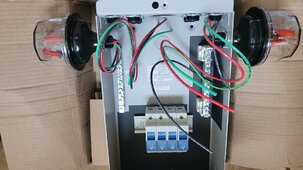
yabert
Solar Enthusiast
No! The limitation is often the ability to break DC voltage (DC rated AIC).Most fuses are way over the voltage used. The voltage limitation is all about the insulation.
robbob2112
Doing more research, mosty harmless
No! The limitation is often the ability to break DC voltage (DC rated AIC).
The DC voltage rating isn't the AIC rating - they are different all together. The voltage rating is where it won't arc over/through the insulation into anything else. The AIC rating is the ability to break an arc inside when it opens. The AIC is always rated in amps or kilo-amps, not volts
Last edited:
Hedges
I See Electromagnetic Fields!
- Joined
- Mar 28, 2020
- Messages
- 21,191
AIC rating can vary with voltage.
 www.bluesea.com
www.bluesea.com
Interrupt Capacity

| 10000A @ 14V DC 5000A @ 32V DC 2000A @ 58V DC |
MRBF Terminal Fuse - 30A - Blue Sea Systems
Space-saving ignition protected fuse for 30 to 300 Amp loads. Must use with Terminal Fuse Block.
Similar threads
- Replies
- 90
- Views
- 10K
- Replies
- 12
- Views
- 908



